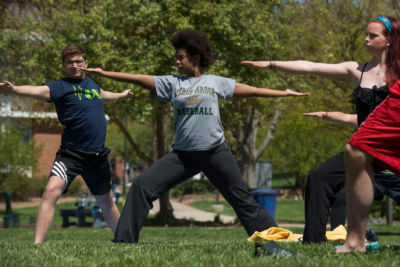By: Jenny Goransson, a Mason doctoral candidate in Writing and Rhetoric, Graduate Writing Coordinator at Mason’s University Writing Center, and Clinical Coach in Mason’s SEED program
“To optimally succeed with writing, one’s primary allegiance must be to the present moment, not to the text, to the now of process and not the future product, and this requires being fully attentive to the fragmentary, continuously mutating and migrating performances of now.” – Alexandria Peary
Mindful writing offers a unique pathway to fostering well-being by nurturing a deeper connection between you as a writer and your inner landscape. By grounding yourself in the present moment and acknowledging the interplay between your body and mind, you can cultivate resilience, alleviate writing blocks, and experience a profound sense of creative fulfillment. The practice of mindful writing is not only a tool for enhancing your writing proficiency, but also a powerful approach to strengthening your well-being.
In the summer of 2020, during the COVID lockdown, I was surprised to see the topics of mindfulness and yoga show up on the syllabus of a course I was taking as part of Ph.D. coursework (“Emergent Pedagogies” with Dr. Michelle LaFrance). The height of a raging pandemic was perhaps an appropriate time to read about innovative ways to manage cognitive and emotional challenges – both in my writing and more broadly. I connected deeply to two books specifically: Alexandria Peary’s Prolific Moment: Theory and Practice of Mindfulness for Writing and Christy Wenger’s Yoga Minds, Writing Bodies: Contemplative Writing Pedagogy. Both books focus on helping writers connect to the present moment, and to their physical bodies, to overcome writing blocks and grow in their writing.
Peary describes her own experiences teaching mindfulness-informed composition courses that incorporate exercises such as meditation, body scan, and mindful free-writing into instruction. She argues that writing instruction has traditionally focused too much on a writer’s past or future experience, without helping writers connect to their present experiences and their intrapersonal rhetoric. Intrapersonal rhetoric is essentially what psychologists refer to as “self-talk,” the internal language we use to narrate our present experience. It is a persuasive language we use on ourselves, internally, all the time. To Peary, “intrapersonal rhetoric consists of whatever discursively arises as a mental formation during the moment” and “is the most immediate discourse available to students.” She sees intrapersonal rhetoric as a resource that writers can tap in to, to reconnect to the present moment, develop inventive ideas for their writing, and notice the stories they are telling themselves about their writing abilities.
As writers become better at observing their intrapersonal rhetoric surrounding a specific writing task, they are then able to manage it better. They can also be prepared (but not overly reactive) when negative emotions come up. Peary further explores this in a 2019 TEDx talk she gave titled “How Mindfulness Can Transform the Way that you Write,” where she discusses “writing demons,” “monkey mind,” and her own struggles with writer’s block. She explains how mindfulness practices helped her overcome writer’s block and find joy in the writing process again.
Wenger’s book explains the conceptual and practical connections she noticed between her own writing practice and yoga practice, which inspired her to design a composition course that incorporated yoga practices and reflections on the physical body’s role in the writing process. She helped her students build awareness of the present moment, their emotional state, and the sources of their writing blocks. They learned practices for “developing focus and advanced coping mechanisms to deal with the negative emotions of the writing process.”
Practice Makes Present
Prompted by these books and all the time in front of my laptop that pandemic summer, I reflected on my own physical state while writing. I noticed a frequent hunched posture over my laptop, and tension in my upper back and neck. This inspired me to set up my writing space more intentionally. I now use a laptop stand to keep my posture more upright while working. I also started adding yoga stretches and movement breaks into my writing practices. Surprisingly, sometimes it is during those breaks when I think of a fresh approach to a writing challenge I’m facing.
Too often, we think of writing as a purely mental, from-the-neck-up practice. But contemplative writing scholars such as Peary and Wenger, combined with my own experience, have helped me appreciate how interwoven our bodies and minds are. I have found that my own writing blocks are more short-lived since I began paying more attention to the physical sensations of writing (such as the clicking sounds of the keyboard and the smooth surface of the keys on my finger pads) and also to my breath. Peary writes of, “the metronome of the breath, a quintessentially portable, open-access tool: breathing in, I am aware that I am writing; breathing out, I am aware that I am writing.”
Since 2021, I have served as the Graduate Writing Coordinator in Mason’s Writing Center. Part of my role is facilitating the weekly Graduate Write-Ins each Friday from 9:30 a.m. to 1 p.m. for grad students to work on their writing projects in a distraction-free space, in community with other students – both on Zoom and in person. For the past year, I have added an optional 10-minute mindfulness exercise for any of the writers who are interested. I use recorded exercises from sites such as Headspace or the Mindfulness Institute for Emerging Adults (MIEA), and I participate alongside the writers. I keep the exercises brief, so that they can return to their writing projects, but sometimes people are in the mood to stay and chat about the experience. We notice how much tension we are holding in our bodies due to a certain way we’re perceiving our projects that day. We notice that simply paying attention to our inhale and exhale, or the sensation of our feet on the floor, seems to help. Sometimes a few chair yoga stretches and closed-eye moments are just what we need to return to our project with a refreshed mindset
Here are some of the specific resources we liked best. Consider giving them a try the next time you feel stuck or frustrated with your writing. You might try them with a group of classmates or colleagues, if you would like to add the element of community.
- Gatha meditation or walking meditation recordings from the MIEA site
- Chair yoga from Brain Education TV’s YouTube channel
- UCLA’s Self-Compassion Break for Dissertation Writers
- Guided meditations from the Headspace app, like this
Mindful Freewriting
Another useful exercise from Peary is called “mindful freewriting.” You might have used freewriting before as a strategy for brainstorming or reflecting. It is called freewriting because you simply let written thoughts flow freely without filtering them. You can write without worrying about grammar, organization, or word choice. Mindful freewriting adds one additional component to keep us rooted to the present moment: maintaining a focus on the sensation of our breath (or some other attentional anchor, such as your feet on the floor) while writing.
Take a few deep, slow breaths with your eyes closed, before beginning to write. Then, open your eyes and simply observe the natural rhythm of your breath. Describe this sensation in your freewriting. Where do you feel your breath in your body? Is it rapid or slow, cool or warm, jagged or smooth? You might then shift your attention to a different sense, like hearing or smell. Describe in your freewriting what you hear and smell around you, in detail. As you shift to another sense, continue to notice if there are thoughts or feelings that you notice interrupting your focus on the attentional anchor. There is no need to judge yourself for being distracted. Just notice the distraction, and then return to the focus on the prompting questions and your breath. You could do this for just two minutes, or continue for longer if you have time. Another variation you could add is to use the freewrite to reflect on how you feel about an upcoming writing project, as you continue to observe your breath and physical body. Feel free to try mindful freewriting not only to support your overall well-being but also as mental preparation for a writing session.
You are bound to find challenging moments to navigate as you work on any type of writing project. Mindfulness offers you the ability to work through challenging moments with more compassion and calm.
In conclusion, incorporating mindfulness into your writing practices can boost your well-being by enabling you to embrace the present moment well. Practicing mindful writing can help you nurture your creativity with focus and compassion. By connecting your body and mind as you write, you can produce strong writing while also strengthening your well-being.
Additional Resources
- Meditation resources from Mason’s Center for the Advancement of Well-Being. I especially recommend checking out the Intro to Mindfulness courses and retreats, which I have enjoyed myself.
- Alexandria Peary’s blog, which is devoted to mindful writing and overcoming writing blocks free
- Information about the Headspace Student Plan ($9.99/year) and Headspace for K-12 Educators (free)
Write one of these Thriving Together Series features! We’re looking for contributions on all topics related to well-being. Read other Thriving Together Series articles here and contact us at [email protected] for guidelines. Thank you for helping our Mason community thrive together online!






















